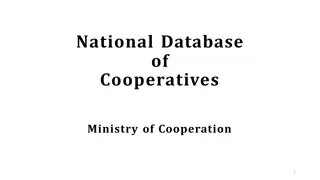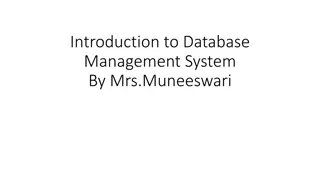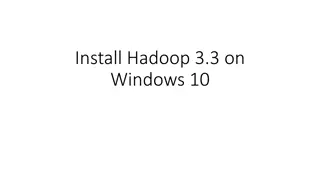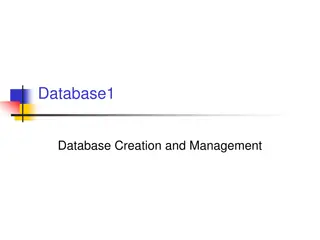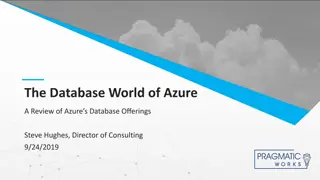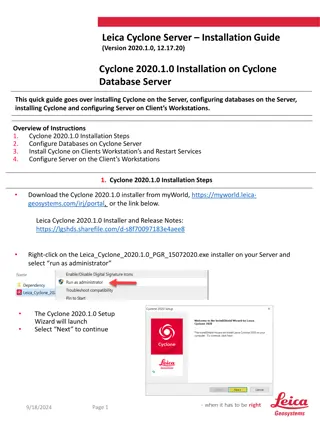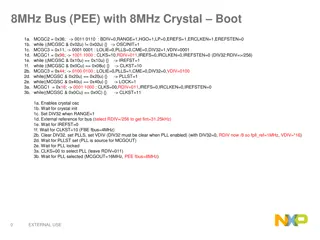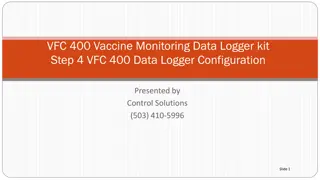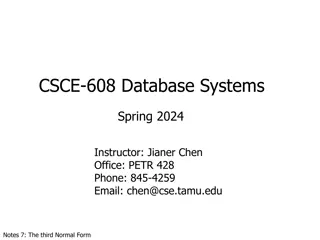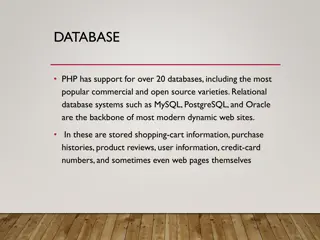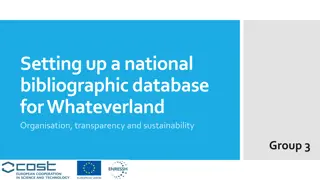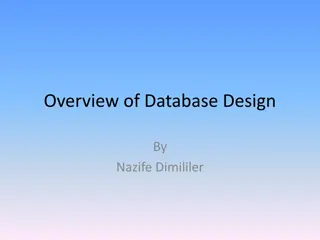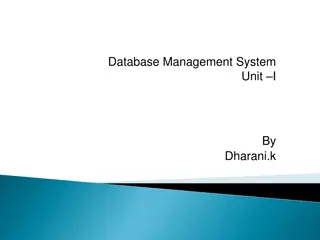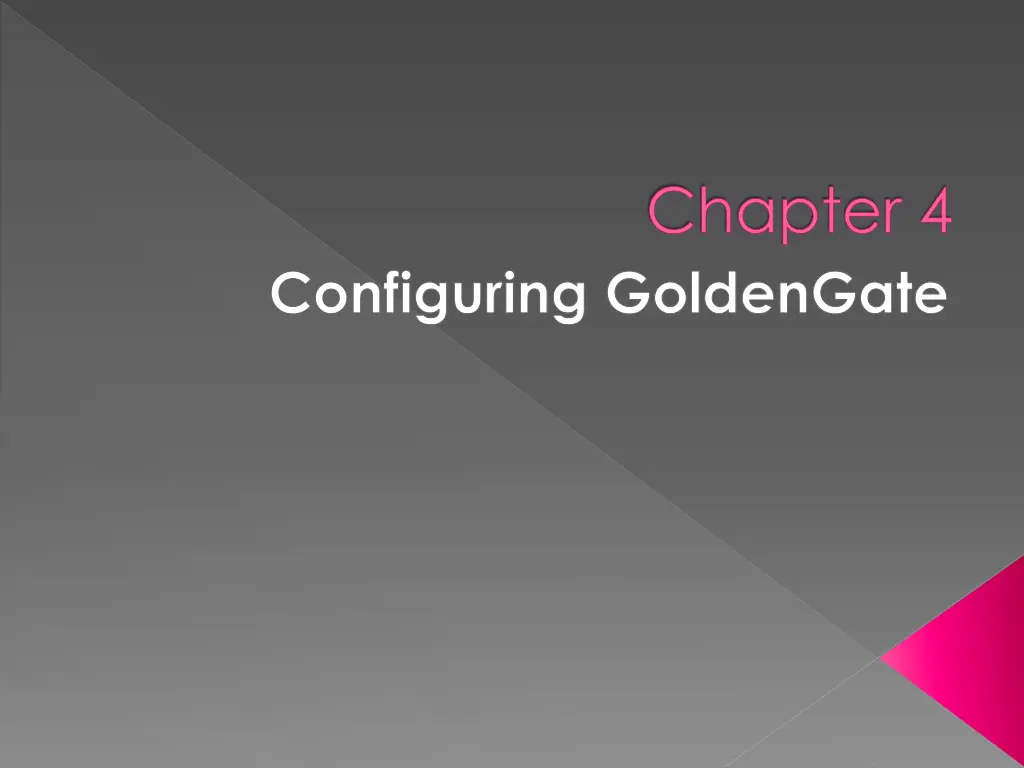
Oracle GoldenGate Database Configuration Guide
Learn how to configure Oracle GoldenGate for Oracle databases, including setting up source and target database users, granting database privileges, configuring supplemental logging, and enabling database logging to ensure seamless data replication.
Download Presentation

Please find below an Image/Link to download the presentation.
The content on the website is provided AS IS for your information and personal use only. It may not be sold, licensed, or shared on other websites without obtaining consent from the author. If you encounter any issues during the download, it is possible that the publisher has removed the file from their server.
You are allowed to download the files provided on this website for personal or commercial use, subject to the condition that they are used lawfully. All files are the property of their respective owners.
The content on the website is provided AS IS for your information and personal use only. It may not be sold, licensed, or shared on other websites without obtaining consent from the author.
E N D
Presentation Transcript
Chapter 4 Configuring GoldenGate
Oracle DB for GoldenGate Create a source database user and a target database user, each one dedicated to Oracle GoldenGate on the source and target systems. It can be the same user for all of the Oracle GoldenGate processes that must connect to a source or target Oracle database: Extract (source database): This user performs metadata queries on the source database, and to fetch data from the source tables for data types that are not directly supported from the redo stream Replicat (target database): This user is used to create the Replicat checkpoint table and to apply DML, DDL, and initial load operations. Manager (source database, if using DDL support): This user performs maintenance on the Oracle GoldenGate database objects if DDL support is being used. DEFGEN (source or target database): This user performs local metadata queries to build a data-definitions file that supplies the metadata to remote Oracle GoldenGate instances.
Database Privileges In addition, execute the following command in SQL*Plus as SYSDBA: EXEC DBMS_GOLDENGATE_AUTH.GRANT_ADMIN_PRIVILEGE('GGUSER','*',TRUE); Where GGUSER is the database user ID used in GGSCI DBLogin commands.
Configuring the source DB GGSCI provides commands to configure the source database to log the appropriate key values whenever it logs a row change, so that they are available to Oracle GoldenGate in the redo record. By default, the Oracle database only logs column values that are changed. The appropriate command must be issued before you start Oracle GoldenGate processing. You will enable some or all of the following supplemental logging types: Enabling database-level supplemental logging Enabling schema-level supplemental logging Enabling table-level supplemental logging
Enabling Database Logging Oracle GoldenGate requires enabling database-level supplemental logging. Log in to SQL*Plus as a user with ALTER SYSTEM privilege, and then issue the following command to enable minimal supplemental logging at the database level. This logging is required to process updates to primary keys and chained rows. ALTER DATABASE ADD SUPPLEMENTAL LOG DATA; To start the supplemental logging, switch the log files. ALTER SYSTEM SWITCH LOGFILE;
Enable Schema Level Enabling schema-level supplemental logging To issue ADD SCHEMATRANDATA 1. Apply Oracle Patch 10423000 to the source Oracle database if the version is earlier than 11.2.0.2. 2. Run GGSCI on the source system. 3. Issue the DBLOGIN command as a user that has privilege to enable schema-level supplemental logging. DBLOGIN USERID <user>, PASSWORD <password> [<encryption options] 4. Issue the following command for each schema for which you want to capture data changes. ADD SCHEMATRANDATA <schema> As an example, the following commands enable supplemental logging for the FINANCE and HR schemas. ADD SCHEMATRANDATA FINANCE ADD SCHEMATRANDATA HR
Enable Table Level To issue ADD TRANDATA 1. Run GGSCI on the source system. 2. Issue the DBLOGIN command as a user that has privilege to enable table-level supplemental logging. DBLOGIN USERID <user>, PASSWORD <password> [<encryption options] 3. Issue the following command. ADD TRANDATA <table> [, COLS <columns>] [, NOKEY]
Creating GoldenGate Instance Each Oracle GoldenGate installation is rooted in the Manager process. This is the controller process that instantiates the Oracle GoldenGate processes, allocates port numbers, and performs file maintenance. Together, the Manager process and its child processes, and their related programs and files comprise an Oracle GoldenGate instance. To run Oracle GoldenGate, a Manager process must be running on all systems that will be part of the Oracle GoldenGate environment. To run Manager, you first create a parameter file for it.
GoldenGate Manager The Manager provides a command-line interface to perform a variety of tasks: Starting, stopping, and monitoring Oracle GoldenGate processes Setting parameters to configure Oracle GoldenGate processes Error and lag reporting Resource management Trail file management The Manager process must be running on each system before Extract or Replicat can be started. Manager parameters are entered in the mgr.prm file under the dirprm directory
To Create Manager 1. From the Oracle GoldenGate directory, run the ggsci program to open the Oracle GoldenGate Software Command Interface (GGSCI). 2. In GGSCI, edit the Manager parameter file. EDIT PARAMS MGR 3. Add the Manager parameters, each on one line. If a parameter statement must span multiple lines, use an ampersand (&) before each line break. The only required Manager parameter is PORT, but DYNAMICPORTLIST is strongly recommended. In a cluster environment, configure Manager with the AUTOSTART and AUTORESTART parameters, so that the Oracle GoldenGate processes start or restart automatically when Manager is started or fails over. Use PURGEOLDEXTRACTS to manage the accumulation of trail files. Save, and then close the file
Globals Parameter Control things common to all processes in a GoldenGate instance Can be overridden by parameters at the process level Must be created before any processes are started Stored in <GoldenGate install directory>/GLOBALS (GLOBALS is uppercase, no extension) Must exit GGSCI to save Once set, rarely changed Parameters most commonly used MGRSERVNAME ggsmanager1 Defines a unique Manager service name on Windows systems CHECKPOINTTABLE dbo.ggschkpt Defines the table name used for Replicat s checkpoint table

